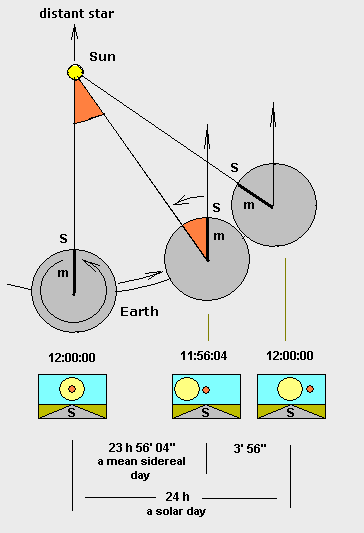The Intriguing Science Behind the Length of a Day
Written on
Understanding What Constitutes a Day
When we think of a day, we usually reference the familiar 24-hour cycle. This is how we organize our clocks and structure our daily routines. However, the term "day" can be defined in several ways.
A sidereal day is the duration it takes for the Earth to complete one full rotation on its axis, which takes approximately 23 hours, 56 minutes, and 4.1 seconds. In contrast, the solar day, which we commonly use, spans the time from when the sun reaches its highest point in the sky one day to the next, amounting to 24 hours.
Where Do Those Extra Minutes Come From?
The Earth rotates at a speed of roughly 1,000 miles per hour, but this isn't the only motion it undergoes. Simultaneously, it travels around the sun at about 67,000 miles per hour.

At noon, when the sun is at its highest, the Earth has rotated for 23 hours, 56 minutes, and 4.1 seconds. However, during that time, the Earth has also moved along its orbit. To allow the sun to reach its next zenith, the Earth requires an additional 4 minutes of rotation. This is akin to a teacup ride at an amusement park, where the teacup spins on a platform that rotates at a different speed.
Thus, the observed solar day averages out to 24 hours.
The Eccentricity of Earth's Orbit
Currently, our orbit is slightly elliptical but not significantly so. Over a cycle lasting around 100,000 years, Earth's orbit will shift between more elongated and closer to circular forms due to gravitational forces exerted by larger planets like Jupiter and Saturn.
This non-uniformity affects the speed at which Earth orbits the sun, impacting the length of the solar day. In January, when we are closest to the sun (perihelion), Earth travels faster and does not require the full 4 minutes to reconcile the difference between sidereal and solar time. Conversely, during July (aphelion), Earth moves slower and needs a little more time to adjust.
The first video titled "Day is NOT 24 Hours Long! Here's why!" delves into the science behind this fascinating phenomenon. It explains how variations in Earth's movement affect our perception of time.
The Center of Our Solar System
Contrary to common belief, the sun isn't precisely at the center of our orbit. Instead, we orbit the barycenter of the solar system, which is the collective center of mass of all solar bodies, including the sun and planets. While the sun is the largest entity and thus plays a major role, it doesn’t occupy the exact center of our path.
The Impact of Earth's Tilt
The effects of Earth's rapid orbital motion on the length of a solar day are generally imperceptible. However, there's a more significant factor at play. The ecliptic, which is the plane of Earth's annual orbit around the sun, is not perpendicular to the Earth's axis. Our planet is tilted at about 23.5 degrees.
This tilt influences the timing of when the sun reaches its highest point in the sky more than the variations in our orbit do. It is also responsible for the change in seasons. Importantly, the length of daylight in summer and winter differs from the definition of the solar day, which we’ve defined as the interval from noon one day to noon the next, irrespective of the season.
Overall, we experience slight variations in solar day length throughout the year, gaining a few extra seconds in January and June, while experiencing lower durations around the equinoxes in March and September. These fluctuations balance out to our familiar average of a 24-hour solar day.
Observing the Differences
For those curious about the differences between sidereal and solar days, stargazing offers a practical way to observe them. If you track the time a specific star rises each night, you’ll find it appears about 4 minutes earlier the following night and continues to do so. Over a month, this difference can add up to several hours.

As you observe the night sky against a backdrop of stars, the distinctions between sidereal and solar days become more apparent, revealing different constellations at various times of the year.
Chapter 2: Further Insights
The second video, "Why Some Days Aren't 24 Hours," provides additional insights into this intriguing topic, explaining the science behind the varying lengths of days on Earth.